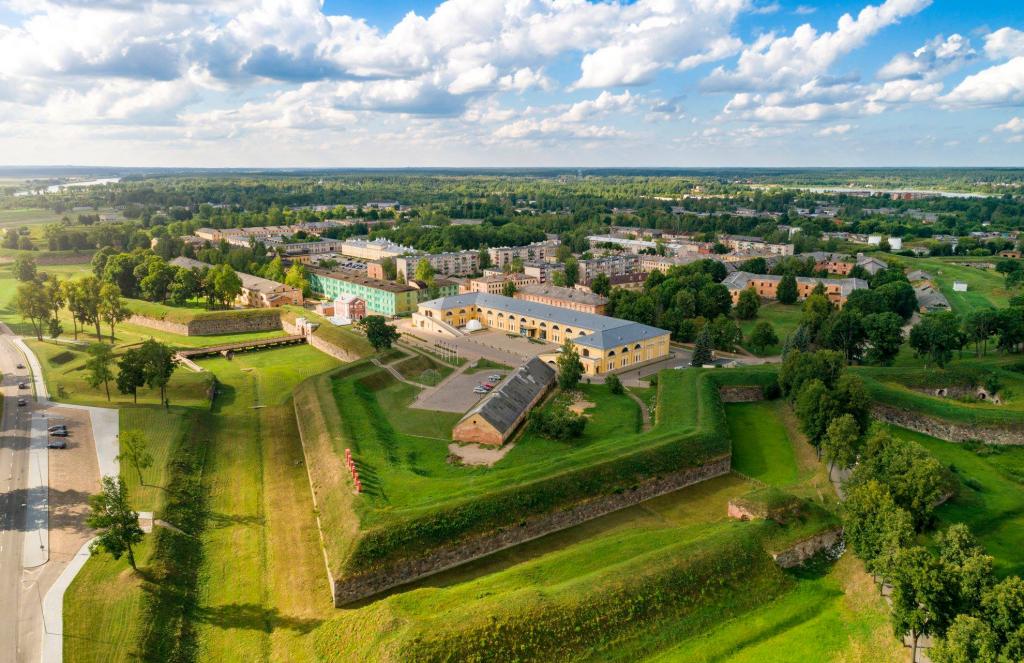Thessaloniki gets ready for its metro launch in November
The underground rapid transit lines have been under construction for almost two decades due to various project delays
 TheMayor.EU logo
TheMayor.EU logo 
Daugavpils Fortress, with the Mark Rothko Art Centre visible in the foreground, Source: Visit Daugavpils
Rejuvenation of the site seems ever more likely
On 9 June, there was a regular meeting of the Daugavpils Fortress Preservation and Development Council in the form of a video conference, during which issues concerning the future fate of several buildings in the historical zone were discussed. The main topics of deliberations were the development opportunities for the fortress hospital (at Hospitāļa Street 6) and the two-storey barracks (at Mihaila Street 11), which were purchased by a company last year.
The Daugavpils Fortress was begun in 1810 as a way of preparation by the Russian Empire for the upcoming Napoleonic invasion, although it was fully completed only in 1878. Its use as a military site continued, under one form or another, until the 1990s when it became state property.
The first major development was the opening of the Mark Rothko Art Centre on the site of the former Artillery arsenal building. The abstract artist was arguably the most famous person to originate from Daugavpils, so it was a good way to pay honour to his work and legacy.
During the last couple of years, Daugavpils Fortress has undergone significant changes in terms of real estate ownership - some objects, such as buildings at Mihaila Street 10, Nikolaja Street 2, etc., were privately purchased from the municipality or from the state government. At the same time, some objects have become the property of the municipality or are in the process of being taken over – e.g. the building at Mihaila Street 2, the 1st bastion area, etc.
There is also an active repurchase of historical real estate between individuals and legal entities. All this shows the growing interest of investors in this part of the city.
A potential investor expressed the wish to create a five-star hotel on the site of the military hospital, replete with spa services and, medical and sports centres while preserving the historical authenticity of the complex. This property, with an area exceeding 10,000 square metres, has not been used since 1994.
The situation with the barracks is slightly different - the object has already been bought out by a local company, which plans to renovate the building, creating an apartment complex and a hotel. However, in preparation for the renovation work, it was revealed that the building should be first provided with sufficient power electricity connections.
The substations in the fortress are not intended for the emergence of new large energy consumers in this area. The members of the Council came to the conclusion that such a task should be solved in a proper way, thinking also about other power connections in the future.
If you want to keep up with how European cities and regions are changing, follow us on Facebook, Twitter and Instagram.

The underground rapid transit lines have been under construction for almost two decades due to various project delays

Now you can get your wine in Talence by paying directly in Bitcoin

That’s because the state has to spend money on updating the railway infrastructure rather than subsidizing the cost of the popular pass

Rethinking renewable energy sources for the urban landscape

The examples, compiled by Beyond Fossil Fuels, can inform and inspire communities and entrepreneurs that still feel trepidation at the prospect of energy transition

Now you can get your wine in Talence by paying directly in Bitcoin

The 10th European Conference on Sustainable Cities and Towns (ESCT) sets the stage for stronger cooperation between the EU, national and local level to fast track Europe's transition to climate neutrality.

At least, that’s the promise made by the mayor of Paris, Anne Hidalgo

The underground rapid transit lines have been under construction for almost two decades due to various project delays

At least, that’s the promise made by the mayor of Paris, Anne Hidalgo

Hostal de Pinós is located in the geographical centre of the autonomous region

Despite its church-y name, the district has long been known as the hangout spot for the artsy crowds

Urban dwellers across the EU are having a say in making their surroundings friendlier to people and the environment.

Forests in the EU can help green the European construction industry and bolster a continent-wide push for architectural improvements.

Apply by 10 November and do your part for the transformation of European public spaces

An interview with the Mayor of a Polish city that seeks to reinvent itself

An interview with the newly elected ICLEI President and Mayor of Malmö

A conversation with the Mayor of Lisbon about the spirit and dimensions of innovation present in the Portuguese capital














